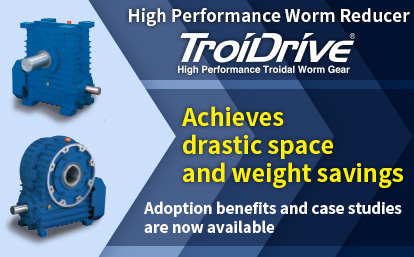Product Info Reducers
Reducers are mechanical device that outputs power obtained from the output shaft of a power source such as a motor by reducing the rotational speed using gears.
The ratio of the number of gear teeth on the input and output sides is the reduction ratio, and the torque at the output shaft is inversely proportional to the reduction ratio.
Our line-up includes three gear types - helical gears, hypoid gears and worm gears - which can be selected according to the motor specification, shaft arrangement (parallel or right-angle shaft) and output shaft shape (solid or hollow) to suit the purpose.
Contents
Reducers Related information
Types and features of gears
The following five kinds of gears are used in our reducer. The features of each gear are shown in the table below.
| Hypoid gear | Cylindrical Worm | Troidal Worm | Bevel gears | Helical Gear | |
|---|---|---|---|---|---|
| Gears |  |
 |
 |
 |
 |
| Axis Position | Right angle shafts | Parallel shafts | |||
| Skew | Cross | ||||
| Efficiency | 80% | 40~70% | 40~80% | 90% | 90% |
| Noise | Good | Excellent | Excellent | Fair | Fair |
| Gear engagement | Both sliding and rolling | Sliding | Sliding | Rolling | Rolling |
| Self-Locking ※ | None | Provided (Reduction ratio 1/60) |
Provided (Reduction ratio 1/60) |
None | None |
※Self-Locking: This is a function of the worm gear that the input shaft side cannnot be turned from the output shaft side.
Generally, reduction ratio is 1/60 as a single-step reduction.
Reducers Product list
- DCBL Hypoid Motor
- Worm Gear Reducers
- Small-Size Gear Motor
- Gear Reducer for Servo Motors
- Miter and Bevel Gear Boxes
DCBL Hypoid Gear Motor
DCBL Hypoid Motor requires no maintenance because the rotor is a permanent magnet and the stator is a coil, eliminating the need for commutators and brushes.
The rotor rotates by detecting the magnetic pole position of the rotor and switching the current-carrying coil.
DCBL Hypoid Motors must therefore be used as a set with a drive circuit (driver).
Tsubaki DCBL Hypoid Gear Motors use permanent magnets and are more powerful and compact than conventional general-purpose motors.
DCBL Hypoid Motors with a motor capacity of 0.2kW, 0.4kW and 0.75kW are available.
※Motor main unit and driver must always be used as a set.
DCBL Hypoid Motor
Model No. DCHM~
This is a DCBL Hypoid Motor with hypoid gearhead for compactness with right-angle shaft.
Standard models with brakes are also available. Communication functions are equipped for various controls.
Despite the name DC brushless motors, these motors are driven by AC power.
※Because of their operating principle, they are called DC brushless motors.
- ・Excellent speed control, less susceptible to load fluctuations and stable rotational speed.
- ・Permanent magnets are used in the rotor, resulting in low loss and high efficiency (equivalent to IE4).
- ・Compact yet powerful output compared to induction motors.
- ・The speed control range is as wide as 1:25, allowing operation from low to high speed ranges.
Size
0.2kW~0.75kW
Reduction ratio
0.2kW:1/10~1/60
0.4kW:1/10~1/50
0.75kW:1/10~1/50
DCBL Driver
DCBL Driver is a dedicated driver for realizing versatile operations of DCBL gear motor.
Unlike conventional induction motors, DCBL Hypoid gear motor does not have a terminal box, and power supply and operation control are performed by connecting cables to DCBL driver.
※Motor main unit and driver must always be used as a set.
DCBL Driver
Model No. DCRD~
Driver for DCBL Hypoid gear motor dedicated for Tsubaki.
Speed control, positioning operation, torque limit operation and various protection functions are equipped.
- ・Various controls can be easily achieved by constantly monitoring the operating status of the gear motor with the driver.
- ・The system supports multiple communication methods, making it easy to integrate it into existing equipment and remotely monitor operating status.
- ・Motor and driver overheat protection and overload protection are provided, enabling quick stop in the event of an abnormality.
- ・A simple holding function can be used to control the motor shaft so that it does not rotate when the motor is stopped.
Basic Knowledge of DCBL Hypoid Motor
Inside structure
It consists of a rotor and stator made of permanent magnets and a Hall IC for rotor position detection mechanism.
Structure of stator :Difference from Brushed Motor
A typical brushed motor has a component called a brush inside the motor that makes contact with the commutator to switch the electric current and rotate the motor.
Repeated mechanical contact causes brush wear and requires periodic maintenance.

On the other hand, DCBL Hypoid Motors have permanent magnets for the rotor and coils for the stator, and have no mechanical contact points. Therefore, the motor does not suffer from wear of parts like a brushed motor and can be expected to have a long service life.

Structure of rotor position detection mechanism: Difference from servo motors
For both DCBL Hypoid Motors and servo motors, the rotational position of the rotor is constantly fed back to the driver, ensuring stable speed control even during load fluctuations.
Servo motors use a high-precision encoder for rotor position detection, which provides excellent speed, torque, and stopping accuracy, but at a high cost.
DCBL Hypoid Motors use Hall ICs instead of expensive encoders, thus taking only the speed control function out of servo motors.
Highly accurate speed control similar to that of servo motors can be achieved at low cost.






